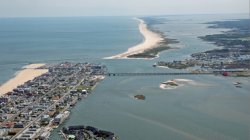
University Calendar
Using Bayesian Networks to forecast barrier island geomorphology and impacts to piping plover habitat due to sea-level rise

About Dr. Ben Gutiérrez
Dr. Gutierrez is a Geologist with the U. S. Geological Survey's Coastal and Marine Geology Program in Woods Hole, Massachusetts since 2005. He received his undergraduate degree in Environmental Geology from the College of William and Mary, his Master's in Oceanography from the MIT/WHOI Joint Program in Oceanography, and his Ph.D. in Geology from the University of South Carolina. His research focuses understanding the underlying geology of different coastal settings, as well as how ocean waves and ocean currents shape the coast. He has also been involved in efforts to expand the participation of under- represented minorities in the Earth and Ocean Sciences through the USGS and the Woods Hole Diversity Advisory Committee.
About the Seminar
The ability to evaluate the impact of sea-level rise (SLR) on coastal landforms and habitats is important for informing management and policy decisions. A particular area of concern exists along the east coast of the United States, where the evolution of barrier islands over the remainder of the 21st century and beyond will require management and policy decisions in order to effectively balance human development demands and the protection of habitat quality. We developed methods to evaluate the evolution of barrier islands and associated habitat changes for piping plovers (Charadrius melodus), a threatened species that relies on beach and barrier island habitats, under different SLR scenarios. Our modeling approach provides probabilistic forecasts of barrier island morphology and habitat suitability under different rates of relative SLR. To implement this approach, we use Bayesian networks to predict the most likely (1) shoreline change rate, (2) barrier island morphology, and (3) plover habitat suitability. We show applications for several national parks and wildlife refuges in the northeastern United Sates. Our results show that distinct geomorphic conditions are associated with different long-term shoreline change rates and that shoreline change rates depend on SLR rates. This modeling framework also allows us to evaluate scenarios related to coastal management plans and/or future scenarios where shoreline-change rates may differ from those observed historically. Initial results show that modest SLR rates may increase the area of suitable piping plover nesting habitat in 50‒100 years and also indicate the level of effectiveness of certain management strategies in promoting habitat availability.